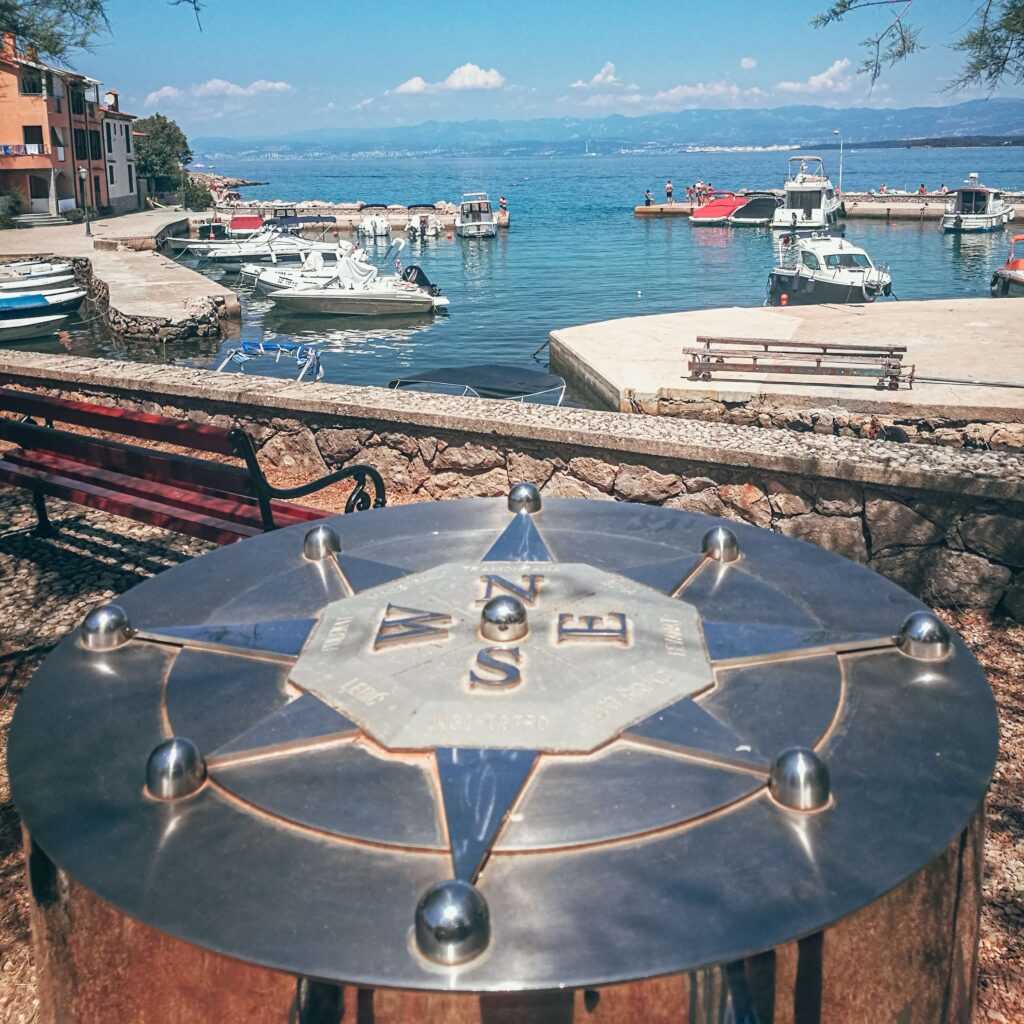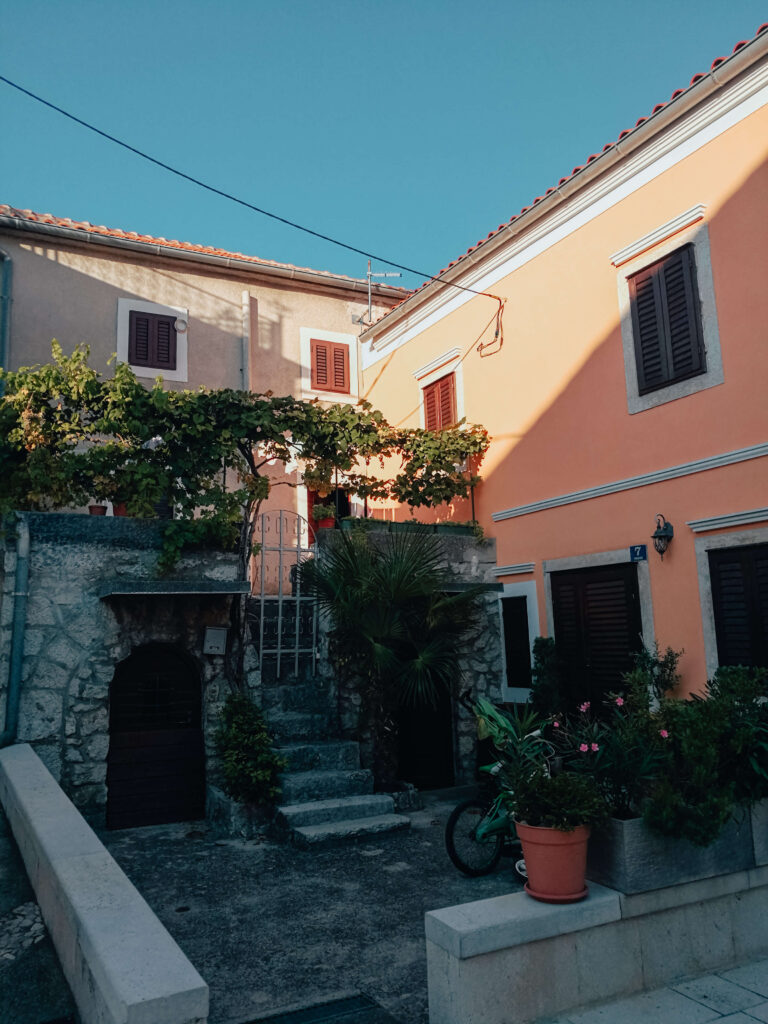
Krk island in Croatia, what to see? How to get there? And a few more useful tips.
Some posts on this website contain affiliate links. I receive a small commission if you use the links at no extra cost to you.
What to see on the island Krk in Croatia? Firstly, let me ask you: What do you associate Krk with in Croatia? With beaches, a long bridge, or maybe a hard-to-pronounce name?
Krk is not as well known among tourists as Dalmatia. However, it is located in the north of Croatia, what attracts people traveling by car. But no problem, if you prefer to fly, you can easily get to Krk by plane or bus.
Krk island is a typical tourist place, but there are also hidden gems, less known, more local places, as well as places with cultural heritage. From the article, you will learn what to see on the island of Krk, how to get to Krk, how to get around the island and some other useful practical information.
Krk island, useful information
Name Krk
Little info about the name. From what I often hear, it can cause a problem and gets confused with another famous Croatian place.
Krk – island in the north of Croatia, in Kvarner region.
Krka – the name of the national park, the Krka river and waterfalls, which are located near Šibenik. (Have you already been? Lovely place.)
Bridge on Krk island
The island of Krk is considered the largest island in Croatia and the largest island in the Adriatic. About 18,000 inhabitants live on the island. Krk is sometimes called the ‘golden island’ because of the beaches.
The island is connected to the mainland by a 1,430-meter-long bridge, opened in 1980. In 2020, the bridge underwent renovation, because salt has a large negative impact on its structure. The problem is also bura – high wind, because of which the bridge sometimes has to be closed for traffic.
At the moment, crossing the bridge is toll-free.
What to see on the island of Krk?
You will not get bored on the island. Although Krk is a typical holiday “beach” island, you will find here monuments, also very important ones for Croatian culture.
Krk town
Let’s start with the island’s capital, Krk town. The history of the town dates back to antiquity. The city walls have been preserved to this day, and they were mentioned for the first time over 2000 years ago.
According to one of the theories, even Homer wrote about Krk in one of his poems, calling the city Koureto.
The largest square in the town is Vela Placa. It was a place of trade during the Renaissance. A tower and a 16th-century well have been preserved on the square. Next to the square is the oldest part of the city walls located.
Another square that you are sure to come across is Kamplin. In the past, it was used for various purposes, e.g. equestrian tournaments. The square is located between two landmarks of the city: the Frankopan castle and the cathedral. The castle was built over several centuries, completed before 1348, and then reconstructed twice. Frankopani is a family of aristocrats, important in the history and culture of Croatia, especially between the 12th and 17th centuries. You will surely see this name often, not only in Krk.
The cathedral is a mix of Romanesque, Gothic, Renaissance, and Baroque styles, and was built on the basis of an early Christian basilica from the 5th century. The tower of the cathedral can be seen well even from a distance.
Next, you walk to the highest point of the old town, Glagolitic Square (Trg Glagoljaša). In its vicinity, you will find 13th-century Franciscan and Benedictine monasteries, and a church that once belonged to one of the monasteries.
As you can see, in Krk town there are lots of monuments. But above all, in the town of Krk it is worth wandering around the streets, sitting down for a coffee and walking along the promenade in the port by the city walls.



Vrbnik (and wine)
Vrbnik is another town which narrow medieval streets invite and delight. A town on a cliff, with beautiful views, known for its wine production.
Žlahtina (precisely vrbnička žlahtina – from the name of the village) is a dry white wine produced from a variety of grapes growing only in the vicinity of Vrbnik. This variety arrived at the island in the 1880s. Therefore, when visiting Vrbnik, it is worth stopping for a glass of wine, or even visiting the vineyard / winery and ordering a tasting set. You can find a list of local wine producers and contacts here.
I visited the Ivan Katunar winery, and I highly recommend it – delicious wine and a beautiful view of the old town.
Back to Vrbnik itself. The monuments include churches, Glagolitic inscriptions, a bell tower, a library, and the remains of the city walls. Vrbnik also has one of the narrowest streets in the world.


Malinska and Njivice
These 2 differ from towns previously described, as they are simply modern tourist towns created on the basis of fishing villages. Malinska is characterized by a big port, from which you can go both ways to the beaches.
Quite quickly, walking along the sea, you reach the village of Vantačići. A little longer walk takes you to Porat, where you can eat in a nice tavern.
Walking in the ‘other direction’, you reach Haludovo beach. Around there, go deeper into the forest, where you come to the ruins of the abandoned Haludovo Palace Hotel. It was one of the most luxurious places in the 1970s (and this splendour can be seen even looking at the ruins). There was also a casino, visited by ‘big names’ guests, for example, Saddam Hussein is mentioned among them. The hotel finally closed in 2001. Since then, there have been several attempts to resuscitate the hotel, but all have failed. The last investor wanted to close access to the beach for people other than hotel guests, what the local and national authorities did not want to agree to.
And to be honest, it’s no wonder, because this beach is on the walking route to Njivice. The promenade called ‘Rajski put’ (Paradise Road) is about a 6-kilometer walk with a beautiful view and the smell of a pine forest.
The port in Njivice is smaller than the one in Malinska, it is still a nice village with several restaurants and cafes in the port.



Baška
It seems that Baška is the most famous place on Krk. Probably because of beaches. The town is divided into two parts. The older one, with narrow atmospheric streets and cafes by the water, and the second one – a promenade along the beach, with typical tourist “from soup to nuts shops” and less inviting restaurants.
It is worth remembering, however, that in Baška there is the Glagolitic Route, and near Baška, in Jurandvor, there is a replica of a tablet, a Glagolitic monument. What is it about? What these monuments are, where to find them while being on Krk and what is the matter with the Glagolitic alphabet, so important on the island of Krk, I describe in this separate article.


Omišalj
The town that impressed me the most, with a wonderful view of the bay. Narrow historic streets, flowery, colourful houses, trees. Quiet, with one cafe and one tavern, but no souvenir shops. A very local character, on the other hand, different from a ‘standard’ Croatian town.
Here you will also find the remains of the Glagolitic script, a loggia from the 16th century, a chapel, and a three-nave church.
What else is there to see on Krk? Punat, with a large and modern marina, and the island of Košljun, where the monastery is located. Stara Baška, a small traditional village with a beautiful beach. Soline Bay or Biserujka cave.



Krk, useful and practical information
How to get to the Krk island?
Not so many people know that… Krk has an international airport! This is Rijeka airport, but it is already on the other side of the bridge (7 km from Rijeka).
During the season, you can fly to Rijeka (on Krk) airport from several European cities: London, Stockholm, Brussels, Milan-Bergamo (with Ryanair) or German airports (with Eurowings).
For domestic connections look at Croatia Airlines and TradeAir.
Important information about getting to and from Rijeka airport! Use only transfers authorized by the airport, because the unofficial ones can leave you on the highway 2 km from the airport, which is rather small pleasure and comfort in the heat.
The transfer to Rijeka at the moment costs 15 Euro. Transfers to/from Omišalj on Krk costs 7,50 Euro. Both transfers must be booked at least 24 hours in advance. The schedule of transfers and all other information including reservation email are available at this link. Note that transfer schedules and rules may change for the summer season when there are more planes landing at the airport.
In summer, there is also transfer to other cities organised.
If not to the airport in Rijeka, you can fly to: Zagreb (about 3 hours by bus), Pula (about 2 hours by bus) or Zadar, which is easy to reach from different cities (around 4 hours). For details about Zadar, I invite you to the article which will be available soon.
How to get around the island of Krk
There is no problem when it comes to public transport and buses between the most important places. Many of the places I write about can be reached by buses, which work quite well and on time (checked personally).
You can check the timetable directly at the stop/stations or on the websites: timetable in Krk and information about the bus station in Krk here.
There are also regular buses between towns on Krk and Rijeka bus station.
Where to sleep on Krk
The most known touristy places are Krk itself, Malinska and Baška, but you can also find tourist infrastructure in other places such as Njivice or Šilo. As is typical in Croatia, most are private apartments, the so-called ‘apartman’, you will also find smaller or larger hotels.
I can recommend great apartment in Malinska. It was renovated and clean, with amazing terrace with seaside view. It was close to the main street but honestly it wasn’t a problem and wasn’t too loud. Location was amazing, just 1 minute walk from the centre and marina. Check it out here.
I’ve also stayed in Omisalj, in city centre, this one. The standard of apartment was quite average (but quite fine still) but location (in beautiful streets) and terrace in apartment were amazing.
What to eat on the island of Krk?
I have already mentioned žlahtina wine. It is perhaps worth adding that there is also a sparkling wine made on the basis of žlahtina, which matures … in chests in the sea. Its name is Valomet.
What else is typical for the island of Krk?
Šurlice – homemade pasta, which is served with meat dishes, e.g., lamb stew.
Pršut (something like prosciutto) from Krk is unique because it is not smoked (as in Dalmatia) but matured in a strong wind in its skin.
And sheep’s cheese, which (if you have a car) can be bought directly at the farm, for example here.
That’s probably enough when it comes to basic information that will allow you to plan your visit to the island of Krk. I hope that I managed to convince you to spend time in this part of Croatia.
Check out more posts regarding Croatia on the blog.




